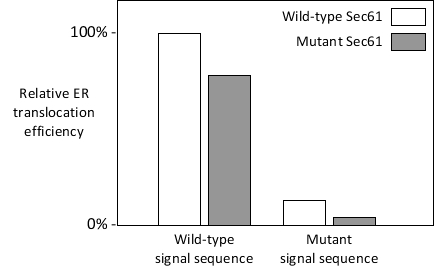Short Answer
The signal-recognition particle is not the only factor that evaluates the authenticity of endoplasmic reticulum (ER) signal sequences in proteins. The Sec61 complex is also able to recognize the signal sequences and "opens" after binding to them. Even single point mutations within the signal sequence of a protein can render the protein unable to enter the ER efficiently, as the Sec61 complex does not readily open in response to the mutant sequence. However, "suppressor" mutations in genes encoding components of the translocation pathway, including the Sec61 subunits, can partially restore the wild-type localization of proteins with mutant signal sequences. Many such suppressor mutations (also called prl mutations) map to or near the "plug" domain in the Sec61 translocon. These mutations, including the deletion of the entire plug, generally result in destabilization of the closed conformation of the translocon and favor its open conformation. Your friend has mutated a certain residue in the plug domain of the yeast Sec61. She has just finished measuring the translocation efficiency of an ER protein with either a wild-type or a mutant (defective) signal sequence, either in wild-type or in her Sec61-mutant cells, and has obtained the following results. Based on these early results, does her Sec61 mutation show a prl phenotype? Write down Yes or No as your answer.

Correct Answer:

Verified
The examined Sec61 mutation s...View Answer
Unlock this answer now
Get Access to more Verified Answers free of charge
Correct Answer:
Verified
View Answer
Unlock this answer now
Get Access to more Verified Answers free of charge
Q26: You set up an in vitro translation
Q27: Which of the following proteins or protein
Q28: Misfolded proteins in the ER may actively
Q29: Indicate whether each of the following descriptions
Q30: In the following graph, the magnitude of
Q32: Indicate true (T) and false (F) statements
Q33: Rough microsomes can be subjected to a
Q34: According to the model for nuclear transport
Q35: Indicate true (T) and false (F) statements
Q36: The following diagram depicts the topology of